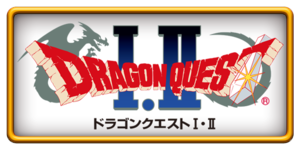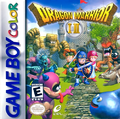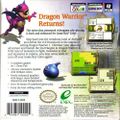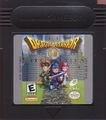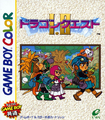Dragon Quest I & II
Dragon Quest I & II is a remake of the first two NES Dragon Quest games, Dragon Quest and Dragon Quest II: Luminaries of the Legendary Line.
Released for the Super Famicom on December 13, 1993, and later re-released for the Game Boy Color on September 23, 1999 in Japan and September 21, 2000 in America, the games feature enhanced graphics and more streamlined gameplay elements taken from the fifth entry of the series.
Though the two titles were separated in 2014 for their mobile phone releases, the changes implemented in the original Super Famicom bundle package have become permanent additions and improvements seen in every version of the games since. The compilation would be revived in the 21st century with the announcement of Dragon Quest I & II HD-2D Remake on June 18th, 2024.
General changes[edit]
- A general-purpose button has been added for faster interaction with NPCs, chests, and doors.
- Movement has been changed from a full tile to half a tile per press of the D-pad.
- Items can be sold to weapon shops and weapons can be sold to item shops.
- Weapons and armour can be equipped the moment they are bought.
- Battle screen backgrounds and spell animations have been added.
- Mist and fog effects have been added to certain dungeons and towns
- Resilience has been added to the list of character statistics, with agility now influencing turn order instead of base defense.
- Experience requirements for each level have been slightly reduced.
- The HP of all boss monsters has been increased, by a factor of 700% in one case.
- Most monsters drop additional Gold, with the exact amount varying between species.
- Stat-enhancing seeds have been hidden in drawers, chests, and pots scattered throughout towns and castles.
- In the Japanese version, a full Kanji script has been implemented.
- In the American Game Boy Color version, characters who had their names changed in the NES Version have been changed to truncated versions of the original Japanese names (e.g. Loto instead of Erdrick, Lora instead of Gwaelin etc.)
Dragon Quest changes[edit]
- In the Japanese version, all characters have multiple sprites that correlate with the cardinal directions, removing the infamous "crab walk".
- Monster spell resistance has been altered from units of 16 to II's system of 8 levels of resistance.
- Enemies can now have true spell immunity for the max resistance, rather than lowering spell accuracy to 1/16th (6.25%) at most.
- The layout of several locations has changed. Most notable are Craggy Cave, which has been completely rearranged, and Dragonlord's Castle, where most floors are different.
- The green dragon and golem bosses now appear as as overworld sprites instead of merely being trigger tiles.
- The Dragonlord's true form is color corrected to better match Akira Toriyama's artwork.
- The Game Boy Color version includes an intro sequence depicting the kidnapping of Princess Gwaelin.
- In the town of Tantegel (Brecconary in the original US NES release) there is a female NPC that follows the player around town after talking to her. If the player stays at the inn while she is following him, the innkeeper will comment "You were up late!" This can also happen while the player is carrying Princess Lora (Gwaelin in the original US release).
Dragon Quest II: Luminaries of the Legendary Line changes[edit]
- The cutscene depicting the siege of Moonbrooke developed for the American NES release has been incorporated into the opening of the game in all subsequent versions.
- Ground-level backgrounds have been added to the various towers via parallax scrolling, giving a better impression of height.
- When purchasing an item, a list of equipable characters and affected attributes will be displayed.
- The Prince of Cannock can now equip Erdrick's Sword and the aurora blade.
- The Prince of Cannock will suffer a curse inflicted by Hargon if the party sleeps at the Beran inn. The curse will be lifted by retrieving a Yggdrasil leaf from a southern island, but the player can leave the prince behind and finish the game with the two remaining luminaries if they desire. Doing so will slightly alter the dialogue of the ending.
- Attacks aimed at monsters who were defeated before the blow could land no longer whiff and will be redirected to another monster.
- Sizzle and Kaboom deal more damage, rising from 17~33 and 55~68 to 50~65 and 68~92 respectively.
- Kabuff and Kasap affect their respective stats by 50% instead of 12.5% (1/8th).
- Some of the effects of Hocus Pocus no longer work on bosses, namely the confusion effect and causing enemies to flee in terror.
- Malroth will no longer cast Fullheal during battle.
- The US Game Boy Color version removes the censorship from the NES version: The churches retain their original crosses instead of being changed to stars and dead party members are represented by coffins with crosses on them instead of ghosts.
Development[edit]
The compilation came about when series creator Yuji Horii noticed that a new generation of gamers were playing Super Famicom games but did not have older Famicom systems of their own, and were thus unable to experience the series from the beginning. He had originally planned to included Dragon Quest III to have the entire Erdrick Trilogy available in one package, but cartridge size limitations prevented this from happening [1].
Focus was placed on updating the two games for the modern audience of the early 90's, implementing the superior controls and quality of life improvements that the series had accumulated over the years for a richer play experience. The graphics and sound used Dragon Quest V as a basis and were taken one step further through the hardware knowledge Chunsoft accumulated developing the prior game, such as the spell animations seen in battle. The inclusion of kanji to the games' and the larger memory capacity of the cartridge allowed the developers to embellish certain lines of dialogue, but refrained from including new scenario additions[2].
Credits[edit]
- Original SFC version
Scenario & game design[edit]
Character designer[edit]
Music composure[edit]
Chief programmer[edit]
- Kouhei Tamura
Programming support[edit]
- Manabu Yamana, Jinji Horagai, Yutaka Gyotoku
Scenario assistant[edit]
- Sachiko Sugimura, Hiroshi Miyaoka
CG designer[edit]
- Shintaro Majima
Sound programmer[edit]
- Dogen Shibuya
Sound programming assistants[edit]
- Takenori Yamamori, Chiyoko Mimata
Development manager[edit]
- Taichi Inuzuka
Production staff[edit]
- Shigeki Maruyama, Daizo Shimamura, Mariko Iida
Producer[edit]
- Yukinobu Chida
Publisher[edit]
- Yasuhiro Fukushima
Gallery[edit]
Dragon Quest I & II on the Super Famicom. (Front)
Dragon Quest I & II on the Super Famicom. (Back)
Dragon Warrior I & II on the GBC.
Dragon Quest I & II on the GBC.
Game Boy official guide.
Game Boy V Jump guide.
Game Boy Poster Side 1. (Artwork)
Game Boy Poster Side 2. (Map)
The borders seen when played on the Super Game Boy.
Test sprites for the GBC version, featuring the Turn A Gundam & Pikachu.
DQ Times coverage[edit]
Trivia[edit]
- Hidden in the game code for the GBC Version of the compilation is a sprite of Pikachu from Pokémon.[1]
- The art assets for the compilation would be repurposed nearly three years later for the Satellaview version of the first game, BS Dragon Quest
See also[edit]
References[edit]
- ↑ — まず『ドラクエI・II』のほうですが、ついに発売日が12月18日に決まりましたね。それで、『I•II』をスーパーファミコンで出そうとしたきっかけは何ですか? 堀井雄二(以下堀井): そうですね、時代がスーパーファミコンになっていて、スーパーファミコンしか持っていないって人も多くなってきましたよね。そういう意味で、『ドラゴンクエスト』を頭からやりたいっていう希望もあったものですから、移植していいかなって。その際にやっぱり『I』だけじゃあまりにもいまの時代に寂しいと思うので。本当は『I』〜『III』をいっしょにと思っていたのですけど、そこまでの容量はなくて、せめて『I・II』をいっしょにということになったわけです。
- ↑ ―シナリオ的にはどうですか。ファミコン版で楽しんだ人でも、楽しめる隠しシナリオなどは用意されていたりしないのですか? 堀井: シナリオはそれほど変わっていないので、懐かしさがあるでしょうね。ただあの当時メモリーもなくて、いろんな意味でそつけなかったりした部分はある程度味つけてセリフなんかも直してます。
